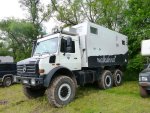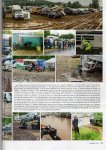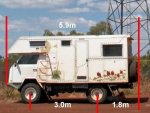The Whitehorse Wallmart. Ouch, but so true.I'm only a truck camper guy, but you did mentioned my home turf ...
I'm in BC and I don't recall ever seeing a large expedition type truck off highway in BC - okay, might have forgotten one or two. The few we've seen have been on/at the highway, rest stop, or established CG. Seen a few up North: off Dempster, and of course Whitehorse Walmart.
That said, over the years we have encountered lots of industrial traffic off highway in Western & Northern Canada. Five tons, ore trucks, Fat boy log trucks, tractors hauling huge drilling equipment etc. So I'd say yes 35' would be doable on main resource roads and bridge limits wouldn't be a problem.
Where you'll miss out is exploring the side roads - and finding the camp spots, waterfront or view they might access. True, some may have been built for industrial vehicles but they deteriorate, bush in, wash out, are decommissioned, cross ditched etc. Your not gonna drive a 35' rig down those roads billiebob posted, let alone a log truck, for FOTA (fear of turning around) or FOGS (fear of getting stuck)
So you'll likely be on the mainlines and camping with the larger trailers and odd C-class in clearings, staging areas and similar easier access campspots (and I say that knowing some guys will take trailers anywhere they fit). You "could" venture into the bush but whether you will is another thing.
However, you wrote getting away from civilization rather that away from people so a large vehicle should still be good and certainly more comfortable inside than our little camper.
ON EDIT I'll add there can also be a time issue. Guy on a quad will check out every side road 'cause it's fast and fun. The larger, less agile rig might still be capable but will go much more slowly, and there's always those worries... So that side road to explore and maybe find a nice lunch or camp spot could be a 3 or 4 hour commitment. Too many duds and it can become tiresome. It's no wonder folks become creatures of habit and return to the familiar spots.
Having a lot of time and curiosity can change the equation though !
You are using an out of date browser. It may not display this or other websites correctly.
You should upgrade or use an alternative browser.
You should upgrade or use an alternative browser.
Realistic weight or length limits?
- Thread starter driveby
- Start date
Classic example of commenting without knowing
Solar panels, charging while driving, one battery installed, one always on charger ready to switch out, vastly improved range is already happening. And who says I'm trying to be 'clean' when I'm driving a 10 ton diesel beast? And I'm building the damn thing to avoid 'campgrounds'.
But thanks for imagining...
I re-read the comment that I was referring to. You are too subtle for me. I thought you were talking about powering some four wheeled adventure vehicle with a battery and charging it while on the road without support. I do know how that would (not) work.
Now I think you are talking about a motorcycle? And charging it from your 6x6? I can see the attraction in that. The new 2022 KTM Free Ride now has a swap-able battery and the price is getting reasonable.
We are planning out a build. Looks like a 6x6 class chassis is likely. But since I'm still researching and questioning things I have a couple basic Q.
EU has a 7.5T weight limit or you are into commercial/restricted territory? Easy to get around or a really bad idea to overshoot 7.5T?
Along those lines is there a max weight folks have seen that really prohibits access to areas?
Is there a wheelbase/length that really starts to limit you?
From what I can gather a LOA of 35' is doable but I'd like to fact check that for BLM areas or forestry roads. I know a lot of coastal BC forestry roads near mountains that a Jeep TJ is too bigWhat has your experience been?
Have you noticed a lot of weight limits on roads/bridges where something over say 20K or 30K pounds becomes a no go?
We are coming out of a Class A with lots of space and storage. And since the plan is to venture further away from civilization for longer, storage/fridge/freezer space seems to be a priority.
How many people? Do you want beds to be permanently in place or foldable, so how much living inside will you do (weather and trip length dependant) compared to living alongside?
Three people with fixed beds in bad weather extended trips mean a long camper so a long chassis. Or two people with a roof tent for shorter nice weather?
Shipping on a roro is I think charged on cubic metres. Many ferries have a camper rate rather than charging a big camper the same as a commercial truck.
The EU licence changes at 7.5tons, but also at 3.5tons, and trailer or not. You can have a leisure vehicle at any weight you want with appropriate licence insurance etc. weight doesn't make it commercial. But do you mean registered in the EU or just visiting?
Old places in the EU have restrictions on size and weight depending on what the requirements were 300 years ago or whatever. A decent road map combined with a can do suck it and see attitude will allow you to find many places you will and won't fit. Don't stress it.
driveby
Well-known member
@GrizzlyYJ . You're right I should have been more specific on our mission profile. 2 adults, no dog. Long walks in the forest... We do plan to use it for 6-8 weeks at a time as much away from people as possible. Around here in the BC West Coast that means old logging roads or mining access roads with highway stretches in between. Around here wheelbase/turning radius matters. I think that we'd probably almost 100% have a Jeep Wrangler as a toad which means scouting sketchy roads or sites ahead of time would be possible. Obviously that sucks up travel time but we will be remote workers (come on Starlink!) and will have no set schedules. We don't want to "camp" we want to explore. That means a dedicated king size bed, washer/dryer, dedicated shower space and lots of food storage. We want to be as self sufficient as possible in both desert heat and cloudy rain days. Up here that could be the whole 6-8 weeks with hikes in the snow/mud then back to our warm comfy home on wheels. This is what is driving our size thinking. All those amenities need space to exist, but not at the cost of not being able to get to where want in the first place. As for the EU that's somewhat unlikely for us. Although always good info to know. Same for Australia, we'd probably build/buy a coach for those areas and when we're done sell and move on. That part is completely undefined on our part so for now I'm focusing on North America use cases.
We currently have a 35' class A gas coach which works well for state parks/provincial parks. But those are getting increasingly crowded and hard to get to. And with our size we must reserve further limiting our flexibility. I dream of open waterfront beach sites, quiet vistas of mountains. That means leaving the populated centers and heading down increasingly sketchy "roads".
We currently have a 35' class A gas coach which works well for state parks/provincial parks. But those are getting increasingly crowded and hard to get to. And with our size we must reserve further limiting our flexibility. I dream of open waterfront beach sites, quiet vistas of mountains. That means leaving the populated centers and heading down increasingly sketchy "roads".
Last edited:
Arjan
Fossil Overlander
The bigger the truck the more restrictions will apply.... We have in the EU a growing number of bigger 4x4 / 6x6 camper trucks and basically up to 40 tons VGW you're fine.
EURO 1 - 6 engine emissions will decide where you can go. But realistically, a camper over 8 tons needs a diet unless some special tools / bikes / cars are carried. I've started an overland truck build based on an Iveco Aurocargo 8 tonnes platform - will take a loong time before it is finished - and the chassis cab gives me 5 tonnes to build the body...
Bon Courage !
EURO 1 - 6 engine emissions will decide where you can go. But realistically, a camper over 8 tons needs a diet unless some special tools / bikes / cars are carried. I've started an overland truck build based on an Iveco Aurocargo 8 tonnes platform - will take a loong time before it is finished - and the chassis cab gives me 5 tonnes to build the body...
Bon Courage !
Peter_n_Margaret
Adventurer
We were at Allrad in 2013. This is Germany's biggest 4WD show.We have in the EU a growing number of bigger 4x4 / 6x6 camper trucks and basically up to 40 tons VGW you're fine.
It rained.
There were big vehicles bogged all over the place and when it came time to leave there was a fleet of tractors at work.



Our "little" Iveco simply drove out with reduced tyre pressures.
I don't read German, but it apparently caught the attention of some of the locals.



I really don't know where they take those massive vehicles. They are certainly not suitable for touring in Oz, IMHO.
Cheers,
Peter
OKA196 motorhome
I read about a family with a MAN Kat 1 6x6 touring Oz who had issues with the width only as far as it meant the tyres encountered all the sharp pointy roots that "normal" 4x4s drove within, lots of punctures.I really don't know where they take those massive vehicles. They are certainly not suitable for touring in Oz, IMHO.
Cheers,
Peter
OKA196 motorhome
I would think "most" big campers at that show are thinking of North Africa though? The Kat in your pic with the blue tow strap really should have bigger tyres for his weight though, they only look like 14.00s?
Peter_n_Margaret
Adventurer
That is a very common story.I read about a family with a MAN Kat 1 6x6 touring Oz who had issues with the width only as far as it meant the tyres encountered all the sharp pointy roots that "normal" 4x4s drove within, lots of punctures.
I agree that is what they are "thinking", but in reality I think most travel from 4WD show to 4WD show in Europe.I would think "most" big campers at that show are thinking of North Africa though?
Cheers,
Peter
OKA196 motorhome
ReluctantTraveler
Well-known member
Resurrecting this thread...
How do you calculate how much you can safely go beyond the rear axle? I know flatbeds, for example, are based on the CA (cab-to-axle) measurement, but I also see motorhomes built on truck or van chassis that go well beyond what you'd see in a flatbed length.
From reading this thread, it sounds like weight distribution is a big part of it.
As a general observation, I typically see "about 2 feet beyond the rear axle." Is 3' doable? 4? 5?
How do you calculate how much you can safely go beyond the rear axle? I know flatbeds, for example, are based on the CA (cab-to-axle) measurement, but I also see motorhomes built on truck or van chassis that go well beyond what you'd see in a flatbed length.
From reading this thread, it sounds like weight distribution is a big part of it.
As a general observation, I typically see "about 2 feet beyond the rear axle." Is 3' doable? 4? 5?
rruff
Explorer
As a general observation, I typically see "about 2 feet beyond the rear axle." Is 3' doable? 4? 5?
You can extend much farther than that if you do it right. My stock truck bed is over 3' past the axle, and 5' is far from silly looking. A lot of RVs are 8' or more, and are low to the ground. For example, this one appears to be close to that amount:

Peter_n_Margaret
Adventurer
In Oz, there is a legal limit of 60% of the wheel base = maximum overhang.Resurrecting this thread...
How do you calculate how much you can safely go beyond the rear axle? I know flatbeds, for example, are based on the CA (cab-to-axle) measurement, but I also see motorhomes built on truck or van chassis that go well beyond what you'd see in a flatbed length.
From reading this thread, it sounds like weight distribution is a big part of it.
As a general observation, I typically see "about 2 feet beyond the rear axle." Is 3' doable? 4? 5?
3.7m is the maximum permitted for a long wheel base vehicle (or for a pig trailer) . And it includes "stuff" hung off the back.
My vehicle was designed with the maximum overhang in mind.
With a tandem axle rig, the wheel base is assumed to be mid way between the 2 rear axles. No idea what happens if there are more than 3.
Still need to watch maximum axle weight limits.

Cheers,
Peter
OKA196 motorhome
Disregarding local regs, just looking at ride handling and safety,
it's ALL about your weight distribution.
Carry your water / waste tanks, battery bank, propane bottles, galley appliances, recovery winch etc forward of an axle
place your sleeping / sitting spaces to the rear and you can extend out as far as practical
which limiting factor is going to be angle of departure when transitioning onto any steeply ascending slope or crossing washouts
which in turn depends on your overall ground clearance, tire size etc
it's ALL about your weight distribution.
Carry your water / waste tanks, battery bank, propane bottles, galley appliances, recovery winch etc forward of an axle
place your sleeping / sitting spaces to the rear and you can extend out as far as practical
which limiting factor is going to be angle of departure when transitioning onto any steeply ascending slope or crossing washouts
which in turn depends on your overall ground clearance, tire size etc
DiploStrat
Expedition Leader
This remains the classic discussion: http://www.silkroute.org.uk/equipment/choosevan.htm
Agree or not as you choose. The bigger/longer/heavier you get, the more comfortable you will be and the more digging you will do.
Agree or not as you choose. The bigger/longer/heavier you get, the more comfortable you will be and the more digging you will do.
ReluctantTraveler
Well-known member
In Oz, there is a legal limit of 60% of the wheel base = maximum overhang.
Similar regulation here in the US.
I'd been planning to use a flatbed as my subframe, since I'm not planning on doing much (any) real offroading. However, most vendors here want to install something much shorter than I'd want based on the CA ratio. Looks like I may be in "custom subframe" territory now.
Similar threads
- Replies
- 0
- Views
- 354
